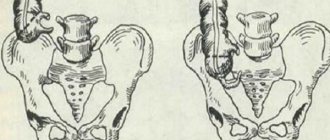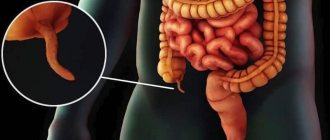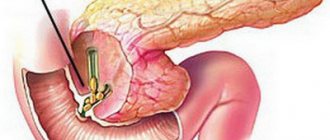Symptoms of a rupture
The most typical and common characteristic of inflammation is severe abdominal pain. After a long period of time, painful sensations appear in the right side. Then, as such, localization of painful sensations is not observed; both the stomach and intestines can hurt. The pain may subside for a while, but then it intensifies again, but does not go away completely. When the patient tries to move, the pain in the right side intensifies.
If the pain goes away, this is a bad sign, as it may be evidence of a ruptured appendix and the death of nerve endings and the onset of gangrenous formation.
In addition to pain, a person experiences attacks of nausea and vomiting along with loss of appetite, frequent urge to urinate, and constipation. Before the development of peritonitis, an adult does not experience a significant deterioration in health. Sometimes there is an increase in body temperature up to 38 degrees. However, when the nature of the inflammation is destructive, the manifestations of the disease are more pronounced.
Inflammation of appendicitis in childhood is much more dangerous, since the disease develops rapidly and there is a threat of inflammation spreading into peritonitis. When the child is ill, he suffers from severe abdominal pain, nausea and incessant vomiting, and high fever.
What is a ruptured appendix
Rupture of the appendix in acute appendicitis is one of the most severe surgical complications , when a purulent-infectious infiltrate penetrates beyond the cecum, fills the peritoneal cavity and contributes to the development of diffuse peritonitis. In fact, the wall of the appendix is perforated, and the contents flow out. Doctors often call the stage of appendix rupture peritonitis.
The high risk of mortality from appendicitis is due precisely to the development of inflammation of the subcutaneous fatty tissue of the peritoneum and abdominal organs, when even surgical intervention does not guarantee complete recovery. The consequences of a ruptured appendix and generalized peritonitis are always serious and require long-term rehabilitation and compliance with all medical recommendations.
Consequences of burst appendicitis
Untimely surgery for an inflamed appendix can result in death.
Surgery to remove appendicitis in itself is not a difficult or dangerous procedure. However, with complications of a burst appendicitis, it develops into peritonitis. In this case, the patient may die.
Peritonitis is an inflammation of the mucous membrane, which is a consequence of infection in the abdominal cavity. Rupture of the appendix is one of the most common causes of peritonitis, as a result of which the entire abdominal cavity can be affected, and the process of intoxication of the body begins. This is a diffuse type of inflammation.
When an infiltrate forms, two variants of the course of the disease are possible. The infiltrate may break through on its own, or the disease may turn into inflammation. To understand what type of disease the patient has and whether there is a rupture, the doctor studies in detail the location and nature of the pain.
Treatment of peritonitis
If the development of peritonitis is diagnosed in the early stages, then successful treatment is possible. Otherwise, the disease cannot be dealt with and the patient will die.
Diagnostics
To make the correct diagnosis, the doctor, after a preliminary examination, prescribes:
- General, biochemical blood test;
- General urine analysis;
- Ultrasound examination, CT scan, x-ray of the peritoneum;
- Abdominal puncture.
Special palpation is also performed (after pressing on the abdominal cavity, the doctor sharply withdraws his hand, at which point the patient experiences increased pain).
Medical assistance consists of removing purulent filling in the abdominal cavity during surgery. Postoperative therapy includes antibiotic and detoxification drugs with enhanced action. The recovery process is quite long; round-the-clock observation in a hospital is necessary.
If there is a small accumulation of emissions from the appendix in the peritoneum, drug treatment in a medical facility is possible. If the infiltrate breaks through, urgent surgical intervention follows.
It should be remembered that diffuse peritonitis cannot be treated with medication, using folk recipes. Delay in contacting a specialized institution will lead to the death of the patient! Particular attention should be paid to children. If a child has complaints of abdominal pain, it is necessary to call an ambulance.
Stages
There are three stages of exacerbation of peritonitis.
- Reactive. It develops within a day and is expressed by severe pain, up to loss of consciousness, constant vomiting and fever. These signs are a reason to urgently seek help from a medical facility.
- The toxic stage can last about three days. During this time, due to rupture of appendicitis, intoxication of the body can occur, the person becomes ill, vomiting almost never stops, blood pressure drops, and the body becomes dehydrated.
- The terminal stage is characterized by temporary relief, but this is a dangerous sign. Necrosis of the nerve endings of internal organs develops. The patient experiences frequent loss of consciousness, sometimes due to severe intoxication he can fall into a coma. This leads to death. It is rarely possible to save a patient at the last stage. It depends on the general condition of the body and the professionalism of doctors.
Appendicitis burst: signs, symptoms and consequences, is it possible to die - Website about
- 25 Oct 2019
- 57
- : 0
If appendicitis bursts, the consequences are very serious.
In this case, it is necessary to immediately transport the patient to a medical facility. Many people experience inflammation of the appendix.
This disease is especially common in people aged 12 to 40 years. Both men and women are equally susceptible to it.
Acute appendicitis is inflammation of the appendix of the cecum. This is a part of the human body that has its own functions. The appendix has been scientifically proven to support the functioning of the immune system. This is where all the intestinal bacteria gather. When it ruptures, it is dangerous for human life.
After a rupture of the appendix, an acute disease immediately develops - peritonitis. Inflammation of the abdominal cavity, or peritonitis, occurs immediately - it is enough for the contents of the appendix to enter the peritoneum. Harmful substances activate the inflammation process and negatively affect the functioning of the entire body.
Causes and symptoms of abdominal inflammation
A ruptured appendix is a serious danger to human life, so if these symptoms appear, you should immediately consult a doctor:
- pain in the right lower abdomen;
- increased body temperature (up to 38 degrees);
- nausea, vomiting;
- general weakness.
These are the first signs that allow you to understand that the patient needs urgent medical help. Even if the pain in the right lower abdomen goes away or dulls over a certain period of time, you should not think that everything is fine. The pain comes in attacks. There is no need to wait for the pain to return to prevent serious complications from developing.
After a rupture of the appendix, a different type of malaise appears in the body. These are severe pains of unknown nature. Further symptoms: frequent vomiting with no relief; elevated body temperature.
An increase in temperature always indicates an inflammatory process; peritonitis is no exception. Abdominal bloating, decreased blood pressure and tachycardia may be observed.
At a more serious stage - loss of consciousness, convulsions and coma.
If a person is suffering from any of the above manifestations of the disease, an urgent consultation with a doctor is necessary, since the patient himself is not able to explain the cause of his illness.
Source:
Is it possible to die from ruptured appendicitis? What happens if appendicitis bursts: symptoms and possible consequences
Simon Kernick is an English thriller writer from Oxfordshire. Since 2002, he has published 14 books, and that might have been the end of it for him, and for his readers. After eating cherries earlier this summer, Simon felt a pain in his stomach and decided to endure it. As a result, he had to undergo emergency surgery, which lasted three and a half hours.
The famous author of thrillers and detective stories Samoy Kernik was proud of his health and good physical shape, so when he felt pain in his stomach, he decided that he had simply allowed himself too much. Unfortunately, the next day the pain intensified. My whole stomach hurt.
Simon, 48, a divorced father of two daughters, is passionate about Thai cuisine, so he decided that the king prawns he had eaten the day before were to blame, but just in case, he consulted Google, as every modern person usually does.
Google scared the bejesus out of him, giving him options for bowel cancer, Crohn's disease, irritable bowel syndrome and appendicitis.
The first thing Simon did was rule out appendicitis—his brother had had an appendectomy at the age of six, and Simon remembered that his brother had a scar on the lower right side of his abdomen, and Kernik himself had pain right under his ribcage.
In fact, it was just appendicitis, and within five days of the appearance of the first symptoms, Simon's appendix burst, and the writer needed urgent help. Kernik, however, decided to make do with paracetamol and visited his doctor the next day.
She palpated his abdomen, but Simon did not feel discomfort in the lower right, and the doctor, concluding that her patient had caught some kind of stomach virus, prescribed painkillers.
The next morning the pain was gone, he Simon still felt bad, he had absolutely no strength. By evening the pain returned and became so severe that Simon was simply bent in half. However, he spent another night at home, trying to sleep. In the morning he called his father and asked him to take him to the hospital.
When he got into the car, he was already screaming in pain. An immediate scan revealed the cause of Simon's pain - a burst appendix. At the same time, the cunning vermiform appendix was hidden behind the colon, so Kernik did not feel pain during an examination by a therapist.
But by the time he was taken to the hospital, Kernick's abdomen resembled a war theater.
Appendicitis is a very common condition, with about 7 percent of people getting it, usually between the ages of 10 and 20, although exactly why this is the case is still unknown. But older people also get it.
The appendix, a narrow finger-like appendage 5 to 10 cm in length, is located at the beginning of the large intestine, on the right side of the abdomen, but due to its length and shape, the tip of the appendix can lie in different positions: in the pelvis, in the anterior parts of the intestines or, in Simon's case, behind the colon.
Therefore, people often think of appendicitis as severe pain in the lower right part of the abdomen, although most people experience pain in the central part. And some, especially children, experience no pain at all - only fever, rapid breathing and loss of strength.
It also happens the other way around: the doctor mistakenly diagnoses appendicitis and removes a completely healthy appendix, and this happens especially often with women - cysts on the ovaries, inflammation of the pelvic organs and the genitourinary system are mistaken for appendicitis.
Appendicitis develops due to blockage of the inlet, and if the process is started, the multiplied bacteria will cause the appendix to literally explode, spreading the infection throughout the entire abdominal cavity.
The most reliable and most commonly used treatment for appendicitis is removal of the appendix.
Nowadays, this simple operation does not even leave a scar, as laparoscopy, that is, surgery on internal organs through tiny incisions, is increasingly being performed.
Simon had just such an appendectomy, but his burst appendix had gone rogue - and it took more than six liters of fluid to flush out all the infection from his body. When he left the hospital, Simon was greeted by the whole family: mother, father and daughters, and his mother, a former nurse, was very worried, since the first patient she had lost had died due to appendicitis.
Two days later, Simon had to return to the hospital - he still managed to develop inflammation. He spent another six days on antibiotics, during which he lost 5 kg.
Fortunately, today Kernik feels great, he has fully recovered and can boast of an enviable appetite.
Such an unpleasant experience made him think that he was damn lucky after all, because his story could have ended not so rosy.
The presence of acute appendicitis is eliminated quite easily. If you have acute appendicitis, you did not go to the doctor on time, or the doctor was not qualified and could not make the correct diagnosis, complications of appendicitis may develop.
The most dangerous complication is ruptured appendicitis. If appendicitis bursts, the consequences will be terrifying.
- If it bursts, it will lead to an extensive inflammatory process, in which case the entire therapy will be long and very difficult, but sometimes it may be unsuccessful.
- Having established a diagnosis in time, an operation is performed, which does not take more than an hour, the recovery period is minimal.
- Literally the next day after the operation, the patient can lead an almost normal lifestyle.
Perforation is the name given to a rupture of the vermiform body. In acute appendicitis, the appendix swells greatly, becomes dirty green in color, and has dying (necrotic) walls.
The size of the perforated body varies, much smaller or the same as the size of the process. The tissue that surrounds the process is inflamed.
Symptoms
When the appendix ruptures, the patient experiences the following symptoms:
- The pain that accompanied the entire time of the presence of an acute appendix weakens, becomes dull and drawing, this is due to the fact that the nerve endings of the appendices have already become necrotic.
- Body temperature remains consistently high.
- Since toxins are absorbed by the intestines, this is certainly accompanied by the presence of intoxication: vomiting does not stop, and intoxication is also accompanied by tachycardia and a lethargic state of the body.
- The skin becomes gray and a coating appears on the tongue.
- The patient's abdomen becomes harder, swells, the muscles on the right side tense very sharply, and pain appears when pressed.
Appendiceal infiltrate
When the appendix ruptures, all its contents may not reach the peritoneum. This could be for a number of reasons.
For example, if the appendix is located behind the cecum. Or the appendix may burst if it is tightly wrapped in an omentum, which isolates it from the abdominal cavity.
Sometimes the appendix ruptures, but the hole may be clogged with fecal stones.
Appendiceal infiltrate is the only contraindication to urgent surgical intervention.
The infiltrate may either begin to fester or even resolve. Resorption takes at least one month.
As soon as its size begins to decrease, pain disappears, body temperature and other indicators return to normal.
This is accompanied by drug treatment. No less than a couple of months after the infiltrate has resolved, an appendectomy can be performed.
If you refuse surgical intervention, be prepared for a recurrence of acute appendicitis, but with more severe complications.
After suppuration of the appendicular infiltrate, what is called an appendicular abscess appears.
Signs of an abscess are:
- The patient feels unwell, alternating with high fever and chills.
- Severe pain appears in the iliac region.
- Frequent vomiting, swollen intestines, and problems with bowel movements.
- The tongue becomes coated.
- On palpation, a formation is felt; it is motionless; this is an infiltrate.
- If the abscess is not operated on in a timely manner, it will burst and fill the intestine or peritoneum with its contents.
- A breakthrough of the abscess into the intestines causes improvements in the patient’s well-being, the body temperature decreases, and when the intestines are emptied, diarrhea is observed with a large admixture of pus, which smells very unpleasant.
- If the abscess ruptures into the peritoneal area, this will lead to the appearance of peritonitis and the appearance of secondary abscesses in different places.
- Specialists operate on the abscess, cut it extraperitoneally, wash the cavity in which it was located, and drain it.
What provokes
Doctors say that damage to the appendix of the cecum can occur for the following reasons:
- With poor nutrition.
- If there is an infection in the body.
- When the process is bent.
- When the opening is closed with feces.
- For inflammatory processes in the intestines.
- For peritoneal injuries.
Diagnosis of the disease
- In order for the doctor to make an accurate and correct diagnosis, he uses ultrasound technology.
- You can also determine whether there is an illness by taking a blood test, and if the level of leukocytes is elevated, then the diagnosis is confirmed.
- The study is carried out to differentiate appendicitis from the following diseases:
- From gastritis.
- From intestinal obstruction.
- For stomach ulcers.
- For acute pancreatitis.
- From pyelonephritis.
- From female diseases in the stages of their exacerbation.
- From pneumonia.
- For acute cholecystitis.
- From urolithiasis.
Source: https://crbfirovo.ru/dieta/lopnul-appenditsit-priznaki-simptomy-i-posledstviya-mozhno-li-umeret.html
Diagnostics
For a doctor to diagnose appendicitis, he must determine:
- Is there pain in the right hypochondrium when pressing on the abdomen?
- Does the pain get worse when a person lies on his left side?
- If you lift your right leg and lie down, does the pain increase?
- If you press on the left side of the abdomen, does the right side also begin to hurt a lot?
These are the basic diagnostic techniques that will help quickly identify the disease. However, if a person has an incorrect location of the appendix or other internal pathologies, then the symptoms may be inaccurate and such diagnostic methods will not always give the correct result. These nuances are the result of complications that can cost the patient his life.
Consequences of a ruptured appendix
When perforation of the appendix occurs in 15% of cases, peritonitis develops in one form or another. Appendiceal peritonitis has a number of features and is equated to perforation of the cecum, and therefore refers to fecal or colibacilar peritonitis.
Rupture of appendicitis can cause the development of local unlimited peritonitis. It appears in the gangrenous form or in the first time after the integrity of the vermiform appendix is broken. A sign of this type of peritonitis is muscle tension in the anterior abdominal wall in the right iliac region, symptoms of peritoneal irritation, and intoxication syndrome.
The appendix is removed, drained, and antibacterial and detoxification therapy is prescribed.
With diffuse peritonitis, the inflammatory-destructive process does not cover the entire abdominal cavity, but only one or two layers. It forms within 6-12 hours after the appendix bursts. It is possible to understand that diffuse peritonitis has developed by the tension of the abdominal wall muscles and symptoms of peritoneal irritation, which cover both iliac regions and the lower abdomen and can spread to the navel and even higher, while the epigastric region is intact.
A median laparotomy is performed, sanitation of the abdominal cavity, drainage with cigar and tubular drainages is necessary. After the operation, the patient is prescribed broad-spectrum antibiotics, medications that stimulate intestinal motility, detoxification and symptomatic treatment.
If 12-24 hours have passed since the appendicitis burst, then diffuse peritonitis has most likely already developed. The patient's abdominal muscles are tense and there are symptoms of peritoneal irritation throughout the entire anterior abdominal wall; signs of intoxication are pronounced.
After 24-72 hours, manifestations of multiple organ failure are already noticeable (acute abdomen is replaced by bloating, motor skills are absent, blood pressure decreases, consciousness is impaired, and the amount of urine excreted decreases). A wide laparotomy is performed, a thorough sanitation of the abdominal cavity is carried out, drainage is introduced, and depending on the severity of intestinal paresis, intestinal intubation or enterostomy is required.
After the operation, antibacterial and detoxification therapy is carried out, drugs are prescribed to stimulate intestinal motility and correct water and electrolyte balance, treatment of multiple organ failure and parenteral nutrition is necessary.
Treatment
An inflamed appendix cannot be restored - it must be removed immediately.
First of all, it is necessary to get rid of inflammation. The patient should be taken to the hospital as soon as possible.
It is contraindicated to use an enema, drink laxatives, or consume food and water. It is not recommended to take painkillers, as this may blur the picture when making a diagnosis.
It is necessary to remove the appendix urgently, because if it bursts, a complication develops. After the operation, the patient undergoes a course of antibiotics.
Modern medicine has learned to perform surgery to remove inflammation without large incisions using an endoscopic scalpel. This helps the patient recover faster and prevent postoperative complications.
What will happen: symptoms of a burst appendix, treatment, diagnosis and consequences of acute appendicitis
Appendiceal rupture (RA) is a rare complication of acute appendicitis. The disorder requires immediate invasive intervention. Sometimes RA is fatal.RA
Appendix rupture
Many people wonder what will happen if the appendix bursts? RA creates an opening for germs to escape into the abdominal cavity. If doctors do not intervene in a timely manner, RA will end in death due to severe sepsis.
The mortality rate from this complication is 1%. Elderly patients with concomitant diseases are more likely to experience complications. With timely diagnosis and treatment, patients with inflammation of the cecum recover. Only a small scar remains in the lower right abdomen. Appendix
Symptoms of a burst appendix
Before RA, there is constant pain in the right lower abdomen - signs of appendicitis. The abdominal wall stretches as more and more pus accumulates in the appendix. If appendicitis is left untreated, part of the colon will rupture.
After intestinal perforation, the pain initially disappears because the pressure in the appendix drops. However, the pain subsides only for a short period of time. Pus, fecal debris and bacteria leave the intestines into the abdominal cavity. There, bacteria multiply and cause life-threatening peritonitis.
With peritonitis, the pain in the right lower abdomen sharply intensifies. The stomach becomes heavy. A typical symptom is release pain that occurs after touching the abdominal wall. In addition to this, the patient suffers from high fever, cold sweats, rapid heartbeat, nausea and vomiting.
Without appropriate treatment, the patient loses consciousness. At the same time, intestinal paralysis may occur, which leads to complete intestinal obstruction. If left untreated, this condition will end in death. Only emergency surgery and intensive antibiotic treatment will prevent death. After treatment, symptoms go away quickly.
What provokes
The cause of RA is always undiagnosed and untreated appendicitis. This inflammation has many causes, but is most often caused by the penetration of a foreign body into the appendix, to which the immune system reacts with increased activity. This causes local inflammation that spreads throughout the appendix.
Appendicitis can be caused by undigested food, feces, grape seeds or small bones. Other provocateurs of appendicitis are bacterial infections that enter the lymph nodes and the cecum.
In many cases, no clear cause of appendicitis can be determined. Risk groups include patients with autoimmune diseases or inflammatory bowel diseases (ulcerative colitis or Crohn's disease).
Obese people also have an increased risk of appendicitis.
Diagnostics
RA can be diagnosed using imaging methods: computed tomography or ultrasound. The classic picture of the disease is appendicitis, in which the pain subsides upon palpation for a short time. A complete blood count shows leukocytosis.
However, these tests are not performed because the patient must be operated on immediately. Without invasive intervention, the disease progresses rapidly and leads to death. Penetration of intestinal contents into the abdominal cavity causes inflammation, severe pain and high fever.
Consequences of a breakup
The consequences of RA are life-threatening. Thanks to modern antibiotics, most patients survive RA without consequences. However, the risk of complications and long-term consequences with RA is higher than with early removal of an inflamed appendix. When scarring occurs, intestinal loops can stick together or narrow, forming adhesions, which sometimes leads to intestinal obstruction.
After surgery, the patient may experience more discomfort requiring further surgery. When the cecum ruptures, bacteria, pus, and intestinal contents enter the abdominal cavity. The result is often extensive peritonitis requiring immediate surgery. The clinical picture can in some cases take on a life-threatening prognosis.Peritonitis
In the case of RA, there is always the danger of an abscess in the abdominal area. Pus deposits can cause chronic inflammation that affects bowel function. In the worst case, we are talking about complete intestinal paralysis.
The risks of surgery and general anesthesia are usually low. Complications include injuries to other abdominal organs, infections, rebleeding, and poor wound healing.
Chronic pain and sensory disturbances may occur.
Treatment
A ruptured appendix can only be treated with surgery. Treatment should be started as soon as possible. After surgery, the patient receives antibiotics to prevent peritonitis.
Analgesics are prescribed to relieve pain from a surgical wound. The vermiform appendix of the cecum does not perform vital functions in the human body.
After a successful operation, no serious complications arise.
If appendicitis is diagnosed before the appendix ruptures, conservative expectant treatment with bed rest, high-dose antibiotics, analgesics, and dietary modifications becomes possible. What is important here is monitoring the patient and being prepared for immediate surgery if RA occurs.
Without surgery, intestinal perforation is fatal in most cases. The operation is indicated for patients with cardiovascular diseases. The procedure is always performed under general anesthesia and can take several hours.
Loading…
Source: https://MedBoli.ru/gemorroj/drugie-zabolevaniya/chto-budet-simptomy-lopnuvshego-appendiksa-lechenie-diagnostika-i-posledstviya-ostrogo-appenditsita
Prevention
To avoid complications and prevent inflammation, you must promptly consult a doctor for help if suspicious symptoms occur. Watch your diet, because poor quality and unhealthy food is one of the causes of inflammation of the appendix.
It is necessary to engage in physical therapy, quit smoking cigarettes and drinking alcohol. If appendicitis has already been removed, you need to constantly monitor your health and well-being, since failure to follow the doctor’s recommendations can lead to secondary inflammation.
Appendicitis burst: symptoms and consequences
Have you been struggling with GASTRITIS and ULCERS for many years without success?
“You will be amazed at how easy it is to cure gastritis and ulcers just by taking it every day...
Read more "
Acute appendicitis or inflammation of the appendix of the cecum is the most common condition requiring surgical intervention. This disease can occur at any age. If the pathology was not diagnosed in a timely manner and appendicitis bursts, then the consequences of the condition can be not only severe, but also fatal.
What is the name of the condition when appendicitis bursts?
Inflammation of the appendix usually lasts 2-3 days. Before rupture, catarrhal changes occur, and later purulent and gangrenous changes are observed.
If medical care is not provided to the patient during this time, the appendix ruptures. When appendicitis bursts and its contents penetrate the peritoneum, a dangerous disease such as peritonitis rapidly develops.
This condition negatively affects the functioning of the body as a whole.
Causes of appendix rupture
The main causes of damage to the appendix can be identified:
- infections;
- poor nutrition;
- bend of the process;
- peritoneal injuries;
- closing the hole with feces;
- inflammation occurring in the intestines.
The condition when appendicitis bursts has dangerous consequences for the patient’s life.
Manifestations of burst appendicitis
The following signs will help you understand that appendicitis has burst:
- severe pain in the lower abdomen on the right;
- general weakness;
- nausea with frequent vomiting that does not bring relief;
- chills and fever.
These are the first symptoms of burst appendicitis, and if they appear, you should immediately seek help from a doctor.
In addition, if a person’s appendicitis bursts, they may experience the following symptoms:
- bloating;
- tachycardia;
- trembling in the upper or lower extremities;
- decreased blood pressure;
- diarrhea or false urge to defecate;
- backache.
With complications, convulsions may occur, the patient may lose consciousness or fall into a coma.
Stages of peritonitis and their signs
Based on the nature of the inflammatory process, the following stages of peritonitis are distinguished:
- Reactive . The duration of this stage is no more than a day. A person suffers from severe pain in the lower abdomen on the right. There is a rise in temperature and constant vomiting. Soreness can lead to shock.
- Toxic . The duration of this stage is up to 3 days. As a result of bursting appendicitis, toxins enter the bloodstream and spread throughout the body, causing symptoms such as incessant vomiting, complete loss of strength, dehydration, increased heart rate and decreased intracranial pressure.
- Terminal stage. The nerve endings die and the pain temporarily subsides; the pulse is practically not palpable. The person loses consciousness and may fall into a coma.
The terminal third stage quite often ends in the death of the patient.
Diagnosis of the condition
To establish an accurate diagnosis, the following diagnostic methods are usually used:
- a blood test can detect an increased level of leukocytes;
- Ultrasound.
Ultrasound helps distinguish acute appendicitis from the following pathologies:
- acute pancreatitis or cholecystitis;
- gastritis;
- intestinal obstruction;
- peptic ulcer;
- pyelonephritis;
- exacerbations of female diseases;
- pneumonia;
- urolithiasis.
In childhood, inflammation of the appendix occurs unexpectedly. The child has a sleep disorder, he is capricious and refuses to eat.
Afterwards, vomiting occurs, stool becomes more frequent and the temperature rises. To relieve pain, the child pulls the right leg towards the body. To avoid a ruptured appendix, your baby should be seen by a doctor immediately.
Is it possible to die from ruptured appendicitis?
When the appendix ruptures, all its contents penetrate the peritoneum. Purulent fluid with a large number of bacteria enters the blood. As a result, infection of internal organs occurs and peritonitis is formed - a pathology dangerous to the patient’s life.
Consequences of peritonitis:
- Bacteremia. Bacteria penetrate into the blood, and the infection spreads throughout the body and metastatic foci form. As a result, the development of meningitis, pericarditis, endocarditis, and osteomyelitis is possible. An abscess forms, leading to death.
- Pylephlebitis. Purulent inflammation of the portal vein, as well as its branches, occurs at lightning speed. Dangerous and fatal.
- Sepsis.
- Thrombophlebitis.
- Gangrene of internal organs.
In addition, peritonitis can cause the development of appendiceal infiltrate. In this state, the tissues of the appendix, intestines and omentum are fused.
In most cases, the consequences of peritonitis are fatal, as the infection rapidly spreads throughout the body.
Peritonitis symptoms with appendicitis
The symptoms of peritonitis are somewhat similar to those of appendicitis, but they are much more severe. With appendicitis complicated by peritonitis, a person usually feels:
- severe pain in the abdominal area
Pain in the lower abdomen increases even with leisurely walking and pressing on the sore spot. A symptom of “imaginary well-being” may also be observed. Over time, the abdominal receptors adapt to pain and the person is able to feel some relief. But this feeling is deceptive, as soon the pain will manifest itself again.
- bloating
- muscle tension in the anterior abdominal wall
- chills, fever, high temperature
- excessive fatigue
- scanty urination
- cardiopalmus
- shortness of breath
- loss of appetite
- severe difficulty with bowel movements
- vomiting
Also with peritonitis, there is an accumulation of fluid in the abdominal cavity.
Vomiting with peritonitis is quite typical. At the very beginning, there may be isolated urges, and then the vomiting only intensifies. In the initial stages of the disease, a person vomits stomach contents.
In this case, the vomit has a greenish tint. A little later they acquire a yellowish tint mixed with blood. This is the release of intestinal contents. With peritonitis, vomiting is profuse and does not bring the patient the desired relief.
Prevention of peritonitis in appendicitis
No one is immune from peritonitis. The best way to prevent it is to consult a doctor in a timely manner when the first pain symptoms appear, which can be localized in the abdominal area. Peritonitis is always secondary. The cause of inflammation of the abdominal cavity can be appendicitis or a number of other pathological conditions.
People who have already suffered from this disease and have been operated on should take more care of themselves. The risk of developing re-inflammation under certain circumstances is quite high.










